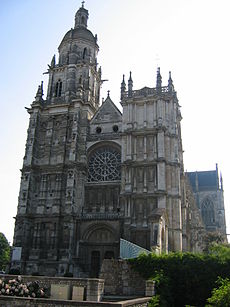Roman Catholic Diocese of Évreux
|
Diocese of Évreux Dioecesis Ebroicensis Diocèse d'Evreux |
|
|---|---|

|
|
| Location | |
| Country | |
| Ecclesiastical province | Rouen |
| Metropolitan | Archdiocese of Rouen |
| Statistics | |
| Area | 6,040 km2 (2,330 sq mi) |
| Population - Total - Catholics |
(as of 2013) 571,000 348,800 (61.1%) |
| Parishes | 32 |
| Information | |
| Denomination | Roman Catholic |
| Sui iuris church | Latin Church |
| Rite | Roman Rite |
| Established | 3rd Century |
| Cathedral | Cathedral of Notre Dame in Evreux |
| Patron saint | Assumption of Mary |
| Secular priests | 77 7 religious priests |
| Current leadership | |
| Pope | Francis |
| Bishop | Christian Nourrichard |
| Metropolitan Archbishop | Jean-Charles Marie Descubes |
| Emeritus Bishops | Jacques David (since 2006) |
| Website | |
| Website of the Diocese | |
The Roman Catholic Diocese of Évreux (Latin: Dioecesis Ebroicensis; French: Diocèse d'Evreux) is a Roman Catholic diocese in France. The diocese comprises the department of Eure within the Region of Normandy. The diocese is a suffragan of the Archdiocese of Rouen, and the current bishop is Christian Nourrichard, appointed in 2006.
Tradition has it that the diocese of Evreux was founded by Saint Taurinus. That tradition claims that he was born during the reign of the Roman Emperor Domitian (81-96), and was baptized by Pope Clement I (ca, 91-101). He set out for Gaul in the company of Saint Denis, who founded the Church of Paris. He went on an embassy to Rome, where he received the blessing of Pope Sixtus (ca. 116-125), after which he returned to Gaul. Shortly after the death of Sixtus, the barbarians overran the province. The last remark, on top of the unlikeliness of the other statements, makes it clear that the story is fiction. An attempt to fix the chronology places Taurinus in the time of Sixtus II (257-258), not Sixtus I. There were indeed barbarian incursions under the Emperor Gallienus (253-268) in those years, and Saint Denis is usually put in the third century; but then the part of the story involving Taurinus' first-century origins must be jettisoned, leaving practically nothing; and one must admit that the third-century date depends on a scholarly conjecture.
Other writers suggest other dates. Chassant and Sauvage opt for dates of ca. 380-410. Le Brasseur indicates a preference for the time of the Vandals in the fifth century, but neither presents any evidence. Gams assigns a date of 412 in his list of Bishops of Évreux, and provides a day of death, August 11. Fisquet provides a rationale for the date of 412, but it too is composed of suppositions and conjectures, not facts. In reality there are no facts at all.
...
Wikipedia
